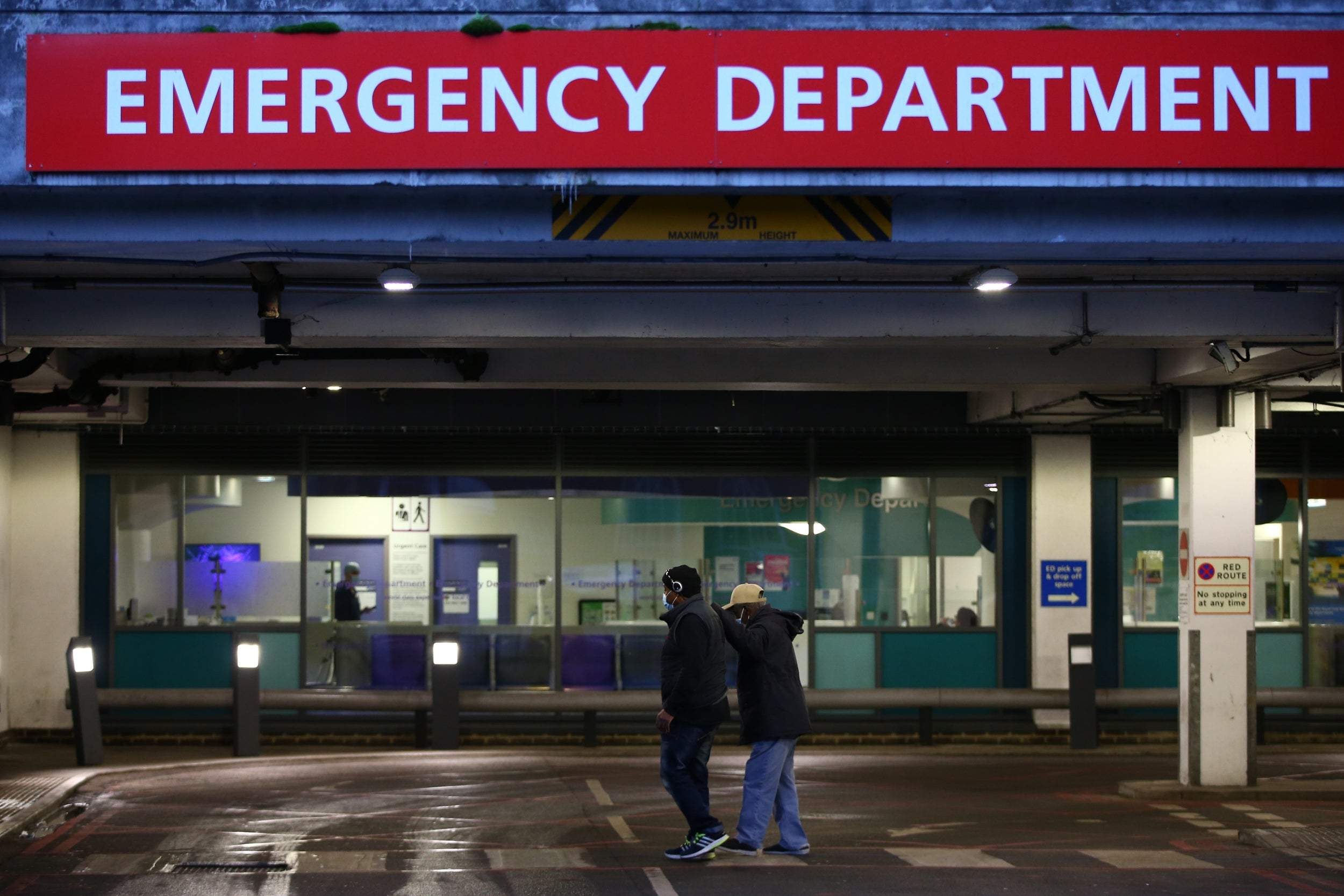Hidden A&E figures revealed as thousands a day forced to wait 12 hours or more
Exclusive A&E departments ‘crippled’ by ‘huge’ trolley waits as patients come to harm, doctors warn

Thousands of patients a day are being forced to wait 12 hours or more in A&E, according to leaked NHS figures.
Internal data seen by The Independent shows that, in a single week in March, nearly 25,000 patients waited for longer than 12 hours after arriving at an emergency department, indicating record delays.
Pressures on the NHS have been increasing, and healthcare leaders have warned of further problems over the Easter break as trusts pleaded with the public to use A&E “wisely” this weekend.
Glen Burley, chief executive of South Warwickshire NHS Foundation Trust, said that while bank holidays are always difficult, this one is more worrying.
He said that in addition to the usual problems, hospitals are facing acute staffing shortages, made worse by Covid, while the “staffing crisis” in social care is “more extreme than ever”.
He added: “Staff are weary, not just because of the demands of Covid but because they see little prospect of an end to the pressures. Alongside all of this, their pay has stagnated and the cost of living has risen. We will of course cope, but it’s hard to paint a picture of hope of a reprieve in the near future.”
Emergency care leaders have warned that the long waits uncovered by The Independent are “crippling” A&E departments, leading to patient harm, with vulnerable patients particularly at risk.
The leaked data shows that the actual number of 12-hour waits in A&E, sometimes called “trolley waits”, is more than six times higher than that given in publicly available NHS figures, and that it has reached almost 100,000 in recent months.
The Independent can also reveal that A&E waits for patients requiring mental health care are significantly disproportionate, with nearly twice as many waiting more than 12 hours compared with figures across all categories of patient. This is despite patients in this category only accounting for 3 per cent of attendances overall.
Royal College of Emergency Medicine president Dr Katherine Henderson said that the 12-hour waiting time figures were “huge”, and that patients were coming to harm, with some patients needing mental health care waiting for days.
Doctors across the country have warned that they are now regularly seeing patients waiting more than 24 hours in A&E, with some patients being left in chairs as trolleys run out.
Feryal Clark, the shadow minister for health and social care, said in response to the figures: “Under the Conservatives, waits in A&E have been unacceptably long and growing longer, well before the pandemic began. Britain deserves better.
“The last Labour government brought waiting times down, and the next Labour government will provide the NHS with the staff, equipment and modern technology needed to treat patients on time.”
‘Trolley waits’ may exceed 100,000
The data leak comes ahead of official monthly A&E figures that are due to be published by the NHS on Thursday. These figures only count the number of hours patients wait after a decision to admit them has been made, and so mask the true scale of the problem.
The official data for February showed that 16,404 patients had waited more than 12 hours following a decision to admit, which was a record at the time.
However, the NHS has internal data, collected since 2021, which measures waits from when a person arrives at A&E. Some figures are available for as far back as 2019.
According to the new internal data seen by The Independent covering just one week in mid-March, nearly 25,000 patients were recorded as having waited for more than 12 hours. This amounts to 8 per cent of patients waiting for more than 12 hours, which is the highest recorded figure so far.
Senior NHS sources have said that by the end of March the number of 12-hour waits is likely to reach 100,000 or more, as figures for November seen by The Independent show nearly 98,000 in November.
For 2022-23, the NHS has a new target, stipulating that less than 2 per cent of patients should be required to wait for more than 12 hours after arriving at A&E.
Speaking to The Independent, one emergency care consultant in the Midlands said it had become normal to come to work and have 20 people waiting who had already been there for 12 to 24 hours.
They said: “It’s just really frustrating, because you want to see patients and there’s no way to see them. It’s just depressing, seeing frail, old people stuck on trolleys or sat on chairs for hours and hours, and the people we saw yesterday still being in the department today. We’ve had one or two quite distressing clinical incidents arising from these waits, where very real harm has happened as a result of not having a trolley for someone.”
Dr Henderson said: “It’s huge numbers. There are far too many patients waiting an incredibly long time. It’s crippling our emergency departments and it’s the most vulnerable patients, for example the mental health patients, who are even more effected than others. We know patients are coming to harm from long waits.”
She said the public should still feel assured about coming to emergency departments, and not leave it too late, but the concern with long waiting times is that patients deteriorate once they are in A&E.
Talking about waiting times for mental health patients, Dr Henderson said it is really important that this data gets into the public domain: “Emergency departments are there for acute mental health crisis just as much as they are for physical health crisis. Not only are [these patients] waiting more than 12 hours, they’re often waiting days. The reality is that we’re seeing mental health patients who are waiting days in emergency departments for a bed.”
Systemic discrimination
Waiting times within emergency departments for patients requiring mental health care are not published by the NHS.
However, the internal data obtained by The Independent reveals that almost 14 per cent of mental health patients turning up to A&E were forced to wait for more than 12 hours in mid-March, compared with 8 per cent of all patients.
The data shows that waits have significantly worsened compared with January 2020, when just 8 per cent of mental health patients waited this long.
Experts have said that the long waiting times are driven by a mixture of issues, including waits for liaison psychiatry, mental health assessments, admissions to beds, and general pressure in A&E departments.
Responding to the figures, Andy Bell, deputy chief for think tank the Centre for Mental Health, said: “Unfortunately, many emergency departments aren’t properly equipped to deal with mental health emergencies. They should have liaison psychiatry services, which allow them to respond to that emergency.
“Obviously, in some cases people may need to be moved to a specialist mental health unit, but in many cases, if there’s liaison services there, they should be able to deal with most things and do that compassionately.”
Mr Bell said there was still a “systemic issue, a bias, against mental health emergencies in the [health] system, and physical health emergencies seem to get a more compassionate response”.
He added: “I think that’s systemic discrimination.”
An NHS spokesperson said: “NHS staff are working incredibly hard to deal with increasing numbers of Covid patients, near record-high levels of A&E attendance, and tens of thousands of staff absences each day because of the virus.
“During the pandemic the NHS introduced 24/7 crisis lines offering mental health support to hundreds of thousands of people a month, with only a fraction of those needing further support in A&E, as well as rolling out a national 24/7 psychiatric liaison service.”
Join our commenting forum
Join thought-provoking conversations, follow other Independent readers and see their replies
Comments


Bookmark popover
Removed from bookmarks